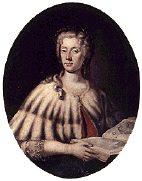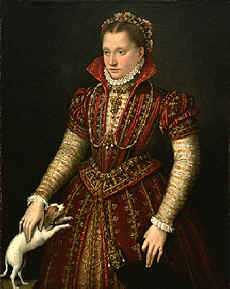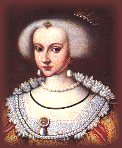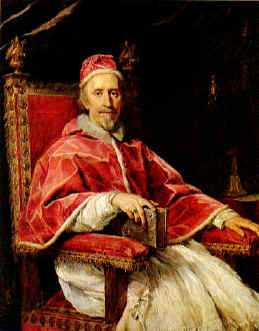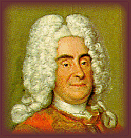| Faustina
is reputed among the most beautiful and graceful women of her times. A botanist admirer
named an iris and an entire family of ferns, the "Marattiaceae," after her and
another, a newly-discovered shell, the "oliva miniacea Maratti." While she was
at Genzano, near Rome, where her father had built and personally frescoed a beautiful
villa that is currently the town's main monument, one of these admirers, Duke
Giovangiorgio Sforza-Cesarini, attempted to kidnap her. The episode is well known because,
at the time, it created a furor prompting her father to close the villa at Genzano never
to return there again. According to the chronicles, the affair didn't go too well for the
Duke because Faustina pulled the knife from one of the would-be kidnappers' hands, almost
killed the Sforza, and escaped with a large gash on her neck. This only increased the
number of admirers because she was deemed to have a force of character to match her
beauty.
Married Faustina, Giambattista gathered thirteen other writers and playwrights--none of
them a "professional" artist, but amateurs who in real life occupied either a
high office or public function--in the garden of the Reformed Priests located on the
beautiful hill of Gianicolo overlooking Rome. In that occasion, they founded the famous
"Accademia degli Arcadi" or, simply, Arcadia whose influence would be felt long
after the original founders were gone and whose poetry, writings, themes and librettos
would be put to music by Brahms, Mozart, Haydn, Handel, Schubert and Bach among others.
I don’t want--nor this is the place--to enter a literary discussion that would
require several pages. But there is no way you will ever understand the reasons for their
popularity unless I say what changes they made. Since, thanks to the movies and
TV, everyone is more or less familiar with the visual arts, I'll try to explain how they
intervened in the sector of operas.
"opera," with a minor "o," simply means "work." Whether
you’re talking of Opera, Melodrama, or Tragedy, the purpose remains essentially the
same: it is supposed to send a message across to the listeners.
You may divide it into three parts: the text, the music and the visual. These three
components act together to "teach" and edify the audience. The visual part, the
action, whether movements are natural or exaggerated, is strictly dependent on the actors'
and directors' ability, so there was nothing they could do about it. About the rest they
could and did, since music and text are especially close in the way they mesh to create
the experience for melody can move the soul in a way no great orator can.
In oratory an argument can be divided in an Aristotelian manner, the three parts being
ethos, pathos, and logos. Pathos being what Aristotle believed music to possess. It is not
a coincidence that opera developed with a relation to rhetoric since there must be an
exordium (opening), medium, and finis. This kind of abstract and rigid structure provided
composers with a skeleton to work with.
Contrary to modern opinion, an opera is drama with music on the side or Dramma per
Musica (drama through music). Originally, the words were to be heard clearly and cleanly.
The text took precedence over the music as the music had to follow the contours of speech.
Extensive musical elaboration was frowned upon for the words had to be intelligible.
What resulted was recitative and the results were musically boring and lacking in
pathos so eventually short songs were included. These quickly developed in to arias which
showcased a singer’s skill. While recitative carried the action of an opera forward,
the arias were akin to monologues in a play.
As the baroque style progressed, dialogues became shorter and less intelligible, arias
more frequent and often contrapposed for effect, thus losing their character of
"monologues," until operas became little else than a series of arias, chorales,
and exaggerated gesturing destined to produce great effect at the expense of plot and
intelligibility.
The Arcads converted the plot into a narratio (statement of facts), propositio
(forecast of the main points in the speaker’s favour), confirmatio (proof),
confutatio (rebuttal), and conclusio (end) using an A-B-A format with the first section
expressing an idea, the second a complementary one, and the third a repeat of the first
with ornamentation and elaboration of the music by the singer. A typical opera of theirs
would start with an instrumental overture of three movements (fast-slow-fast) and then a
string of recitatives containing clear dialogue punctuated by arias expressing the
emotions of the character.
This went on for three acts before a final "happy" chorus and/or duet as most
of these operas ended happily (lieto fine).
Contained within was elegant language and classical characters from antiquity that
spoke of princely values and morality.
It was later objected that their main characters were mere cardboard figures that did
not initiate action but resolved it. Their reply was, how could Alexander the Great show
his clemency until someone tries to harm him so that he could later forgive him? Granted,
realistically this is not what the historic Alexander would have done in the situation,
but these characters are only a medium for the delivery of teachings, nor real
flesh-and-blood representations.
The Arcads revived melodrama by limiting the encroachment of
music, the excessive spectacular effects, and the eccentricities of romantic poets. Also,
their greater simplicity and naturalness in plot, their use of universal themes that were
felt by people of diverse nationalities and ages, turned it into the dramatic form that
enjoyed the greatest popularity in the 18th century.
Arcadia became an instant success, an institution, almost.
Hundreds applied, few--several women among them--were selected. To be appointed an
"Arcade" meant immediate recognition, an instant reputation, for they were the
most visible, sought-after, popular, citizens of Rome and at that time--by extension--the
world: as modern-day celebrities, everything about them was instant fashion.
If you think the components of this restricted group became
"stars," you’re right. But if you think they behaved as such, you’d be
wrong. Society looked at them with respect, in a way asking their intervention on the
artistic scene, followed their every move to see what received their
"imprimatur." Therefore members had to be on top of everything.
Being an Arcade implied hard work, not just a facility with
words or concepts. In addition to the work demanded by their professions of offices, they
had to find the time to read, listen, and see everything. On top of that came the fact
that, run as a non-profit organization, the Academy still needed accountants, clerks,
speakers. And members had to absolve those functions. Then members expected, demanded, and
got from each other a very high editorial production of equally high standards. To
underline the "official" and collective character of that artistic think-tank,
their work was innerly criticized, and that portion which survived the massacre was
invariably published as a collection. Publishers such as Buagni, De Rossi or Salvoni, vied
for the honor, knowing the Arcads had the full support of the Vatican establishment, led
by Cardinal Ottoboni.
As the foremost exponent of a "new," universal
culture, to be an Arcade not only you had to display an impeccable artistic sense in
everything that surrounded you, but you had to do it using simple items of extreme good
taste. Further, your work should also reflect your lifestyle, so that one complemented the
other. Finally, above all, the ensemble had to be useful.
If you think that's easy, you've never waited for my sister
when she's dressing for a party.
To (badly) translate our ancestor’s philosophy,
"One kind of beauty is all
external, entices with appearances, a beautiful, well-ornamented, freshly painted facade
tempting the passer-by into an empty building of precarious balance. Another is all the
opposite. Caring not for looks, guards behind solid walls of rude stone precious gems,
rare perfumes and exquisite objects.
In the same manner, many write beautiful,
well rhymed phrases which delight the ears but starve the intellect while others fill
their compositions with deep thoughts, hidden mysteries, allusions to the senses which
leave only the taste of smoke.
The Arcade artfully merges usefulness
with beauty in such manner that the reader finds under a light, silky cover, noble
thoughts appealing to the instincts in a filigrane so well crafted that it entertains
while teaching and teaches while pleasing."
The translation is not as good as the original. But
then, of course, he was a poet and wrote in Italian, I'm not. Or my personal favorite:
" .....in such manner that the public at large can make the best use of poets by
drawing from them the healthiest and most beneficial feelings and acquiring, by reading
and copying their style, a facility of expression so that men may become eloquent in their
everyday family life, which will inevitably lead to an improvement in our public life."
Giambattista and Faustina became so famous for their wit, elegance, and ability to turn
everything into learned entertainment that Jean Sobiesky, the very King of Poland who a
few years earlier, in 1683, had whooped the Turks and Ottomans who were laying siege to
Vienna, invited them to his palace at Wilanow. The King gave
the couple free rein, and they quickly turned Thursday evening dinners into theatrical
events where the foremost international artists appeared.
King Jean's successor, King August II insisted that
the couple, which in the meantime had given themselves to the task of improving public
learning, should remain. |
